Evidence-Based Nursing Research Report: CVAD Infection and Occlusion
VerifiedAdded on 2023/06/07
|9
|2369
|462
Report
AI Summary
This report delves into the critical aspects of Central Venous Access Devices (CVADs), focusing on the associated risks of bloodstream infections and occlusions. It provides an in-depth analysis of the benefits of CVADs in critical patient care, such as medication and fluid administration, blood product transfusions, and blood draws, while also acknowledging the potential for complications. The report outlines the importance of proper catheter insertion techniques, including the selection of appropriate catheter types and the use of ultrasound guidance to minimize mechanical complications. It emphasizes the significance of maintaining hand hygiene and aseptic techniques to prevent infections. Furthermore, the report explores the causes of occlusion, including chemical, mechanical, and thrombotic factors, and presents prevention and treatment strategies such as catheter patency maintenance, patient education, and the administration of thrombolytic agents. The conclusion highlights the importance of effective prevention and treatment measures to ensure patient safety and facilitate recovery, making this report a valuable resource for healthcare professionals managing critical patients with CVADs.
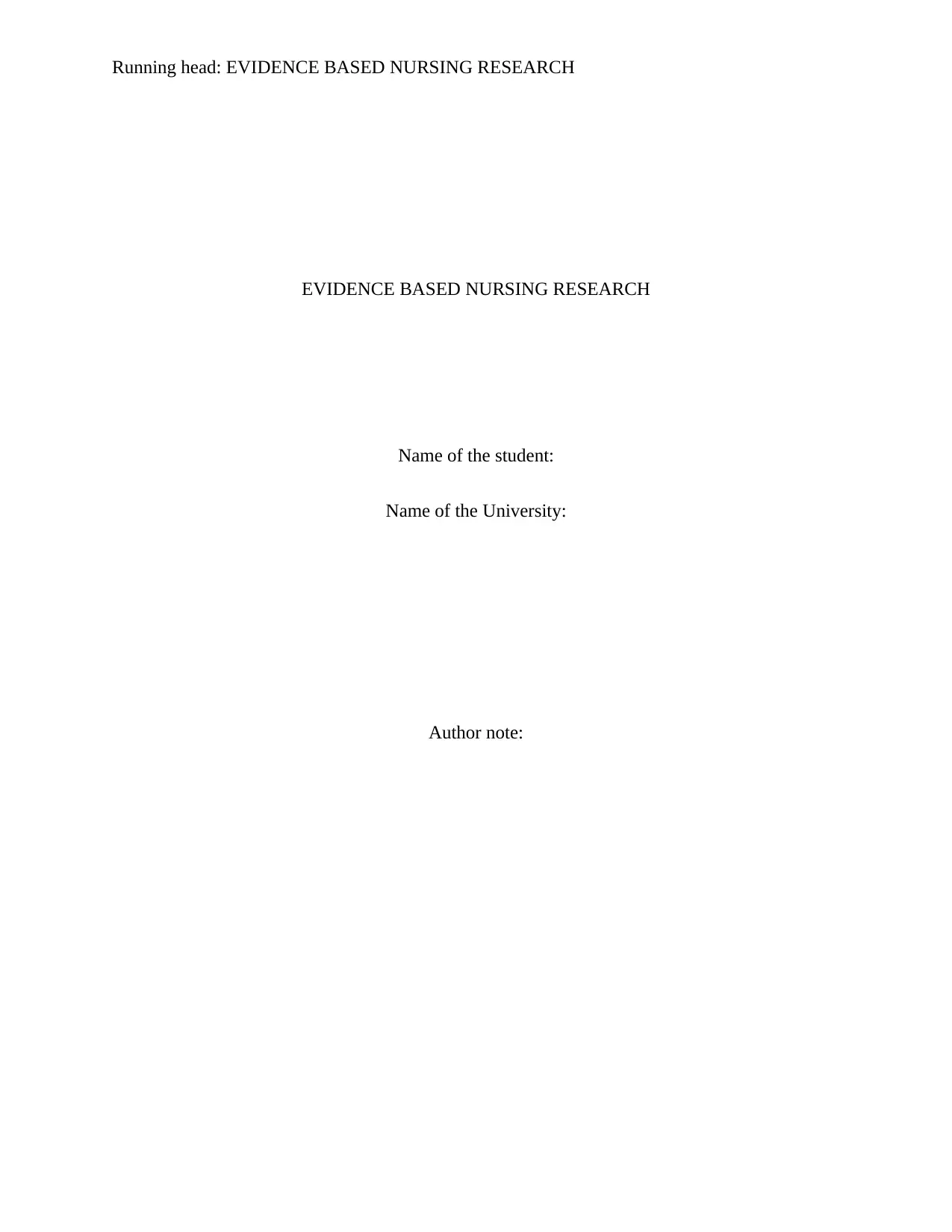
Running head: EVIDENCE BASED NURSING RESEARCH
EVIDENCE BASED NURSING RESEARCH
Name of the student:
Name of the University:
Author note:
EVIDENCE BASED NURSING RESEARCH
Name of the student:
Name of the University:
Author note:
Paraphrase This Document
Need a fresh take? Get an instant paraphrase of this document with our AI Paraphraser
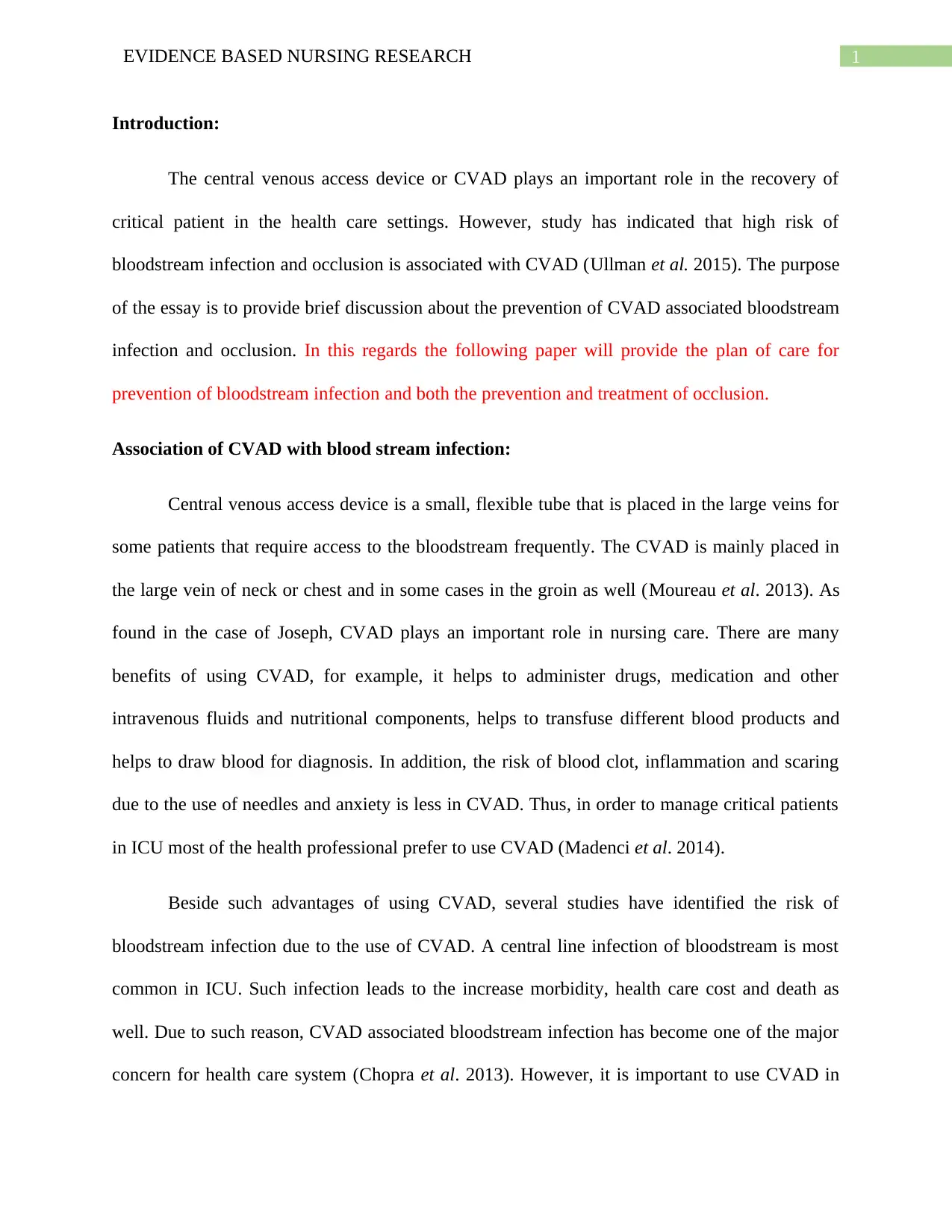
1EVIDENCE BASED NURSING RESEARCH
Introduction:
The central venous access device or CVAD plays an important role in the recovery of
critical patient in the health care settings. However, study has indicated that high risk of
bloodstream infection and occlusion is associated with CVAD (Ullman et al. 2015). The purpose
of the essay is to provide brief discussion about the prevention of CVAD associated bloodstream
infection and occlusion. In this regards the following paper will provide the plan of care for
prevention of bloodstream infection and both the prevention and treatment of occlusion.
Association of CVAD with blood stream infection:
Central venous access device is a small, flexible tube that is placed in the large veins for
some patients that require access to the bloodstream frequently. The CVAD is mainly placed in
the large vein of neck or chest and in some cases in the groin as well (Moureau et al. 2013). As
found in the case of Joseph, CVAD plays an important role in nursing care. There are many
benefits of using CVAD, for example, it helps to administer drugs, medication and other
intravenous fluids and nutritional components, helps to transfuse different blood products and
helps to draw blood for diagnosis. In addition, the risk of blood clot, inflammation and scaring
due to the use of needles and anxiety is less in CVAD. Thus, in order to manage critical patients
in ICU most of the health professional prefer to use CVAD (Madenci et al. 2014).
Beside such advantages of using CVAD, several studies have identified the risk of
bloodstream infection due to the use of CVAD. A central line infection of bloodstream is most
common in ICU. Such infection leads to the increase morbidity, health care cost and death as
well. Due to such reason, CVAD associated bloodstream infection has become one of the major
concern for health care system (Chopra et al. 2013). However, it is important to use CVAD in
Introduction:
The central venous access device or CVAD plays an important role in the recovery of
critical patient in the health care settings. However, study has indicated that high risk of
bloodstream infection and occlusion is associated with CVAD (Ullman et al. 2015). The purpose
of the essay is to provide brief discussion about the prevention of CVAD associated bloodstream
infection and occlusion. In this regards the following paper will provide the plan of care for
prevention of bloodstream infection and both the prevention and treatment of occlusion.
Association of CVAD with blood stream infection:
Central venous access device is a small, flexible tube that is placed in the large veins for
some patients that require access to the bloodstream frequently. The CVAD is mainly placed in
the large vein of neck or chest and in some cases in the groin as well (Moureau et al. 2013). As
found in the case of Joseph, CVAD plays an important role in nursing care. There are many
benefits of using CVAD, for example, it helps to administer drugs, medication and other
intravenous fluids and nutritional components, helps to transfuse different blood products and
helps to draw blood for diagnosis. In addition, the risk of blood clot, inflammation and scaring
due to the use of needles and anxiety is less in CVAD. Thus, in order to manage critical patients
in ICU most of the health professional prefer to use CVAD (Madenci et al. 2014).
Beside such advantages of using CVAD, several studies have identified the risk of
bloodstream infection due to the use of CVAD. A central line infection of bloodstream is most
common in ICU. Such infection leads to the increase morbidity, health care cost and death as
well. Due to such reason, CVAD associated bloodstream infection has become one of the major
concern for health care system (Chopra et al. 2013). However, it is important to use CVAD in
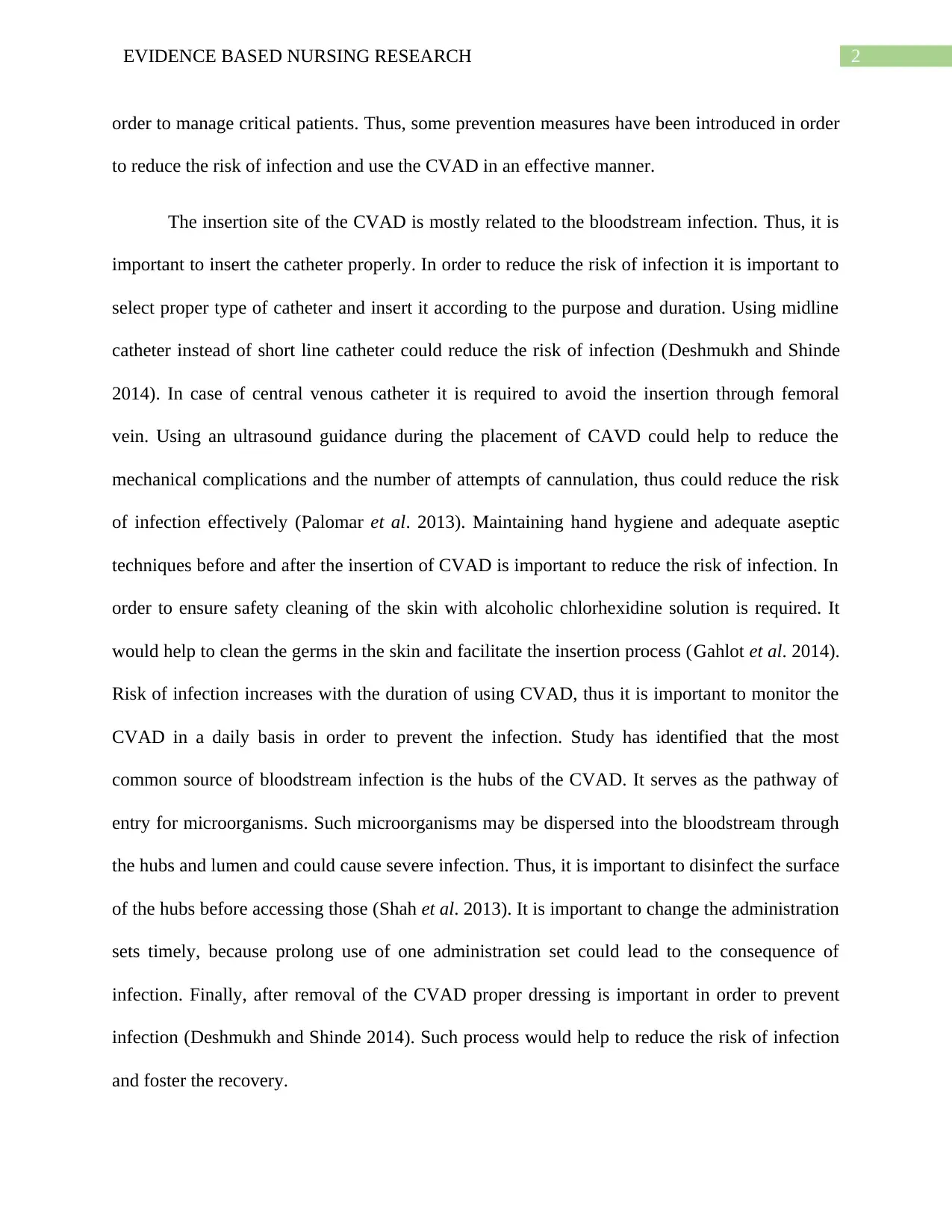
2EVIDENCE BASED NURSING RESEARCH
order to manage critical patients. Thus, some prevention measures have been introduced in order
to reduce the risk of infection and use the CVAD in an effective manner.
The insertion site of the CVAD is mostly related to the bloodstream infection. Thus, it is
important to insert the catheter properly. In order to reduce the risk of infection it is important to
select proper type of catheter and insert it according to the purpose and duration. Using midline
catheter instead of short line catheter could reduce the risk of infection (Deshmukh and Shinde
2014). In case of central venous catheter it is required to avoid the insertion through femoral
vein. Using an ultrasound guidance during the placement of CAVD could help to reduce the
mechanical complications and the number of attempts of cannulation, thus could reduce the risk
of infection effectively (Palomar et al. 2013). Maintaining hand hygiene and adequate aseptic
techniques before and after the insertion of CVAD is important to reduce the risk of infection. In
order to ensure safety cleaning of the skin with alcoholic chlorhexidine solution is required. It
would help to clean the germs in the skin and facilitate the insertion process (Gahlot et al. 2014).
Risk of infection increases with the duration of using CVAD, thus it is important to monitor the
CVAD in a daily basis in order to prevent the infection. Study has identified that the most
common source of bloodstream infection is the hubs of the CVAD. It serves as the pathway of
entry for microorganisms. Such microorganisms may be dispersed into the bloodstream through
the hubs and lumen and could cause severe infection. Thus, it is important to disinfect the surface
of the hubs before accessing those (Shah et al. 2013). It is important to change the administration
sets timely, because prolong use of one administration set could lead to the consequence of
infection. Finally, after removal of the CVAD proper dressing is important in order to prevent
infection (Deshmukh and Shinde 2014). Such process would help to reduce the risk of infection
and foster the recovery.
order to manage critical patients. Thus, some prevention measures have been introduced in order
to reduce the risk of infection and use the CVAD in an effective manner.
The insertion site of the CVAD is mostly related to the bloodstream infection. Thus, it is
important to insert the catheter properly. In order to reduce the risk of infection it is important to
select proper type of catheter and insert it according to the purpose and duration. Using midline
catheter instead of short line catheter could reduce the risk of infection (Deshmukh and Shinde
2014). In case of central venous catheter it is required to avoid the insertion through femoral
vein. Using an ultrasound guidance during the placement of CAVD could help to reduce the
mechanical complications and the number of attempts of cannulation, thus could reduce the risk
of infection effectively (Palomar et al. 2013). Maintaining hand hygiene and adequate aseptic
techniques before and after the insertion of CVAD is important to reduce the risk of infection. In
order to ensure safety cleaning of the skin with alcoholic chlorhexidine solution is required. It
would help to clean the germs in the skin and facilitate the insertion process (Gahlot et al. 2014).
Risk of infection increases with the duration of using CVAD, thus it is important to monitor the
CVAD in a daily basis in order to prevent the infection. Study has identified that the most
common source of bloodstream infection is the hubs of the CVAD. It serves as the pathway of
entry for microorganisms. Such microorganisms may be dispersed into the bloodstream through
the hubs and lumen and could cause severe infection. Thus, it is important to disinfect the surface
of the hubs before accessing those (Shah et al. 2013). It is important to change the administration
sets timely, because prolong use of one administration set could lead to the consequence of
infection. Finally, after removal of the CVAD proper dressing is important in order to prevent
infection (Deshmukh and Shinde 2014). Such process would help to reduce the risk of infection
and foster the recovery.
⊘ This is a preview!⊘
Do you want full access?
Subscribe today to unlock all pages.

Trusted by 1+ million students worldwide
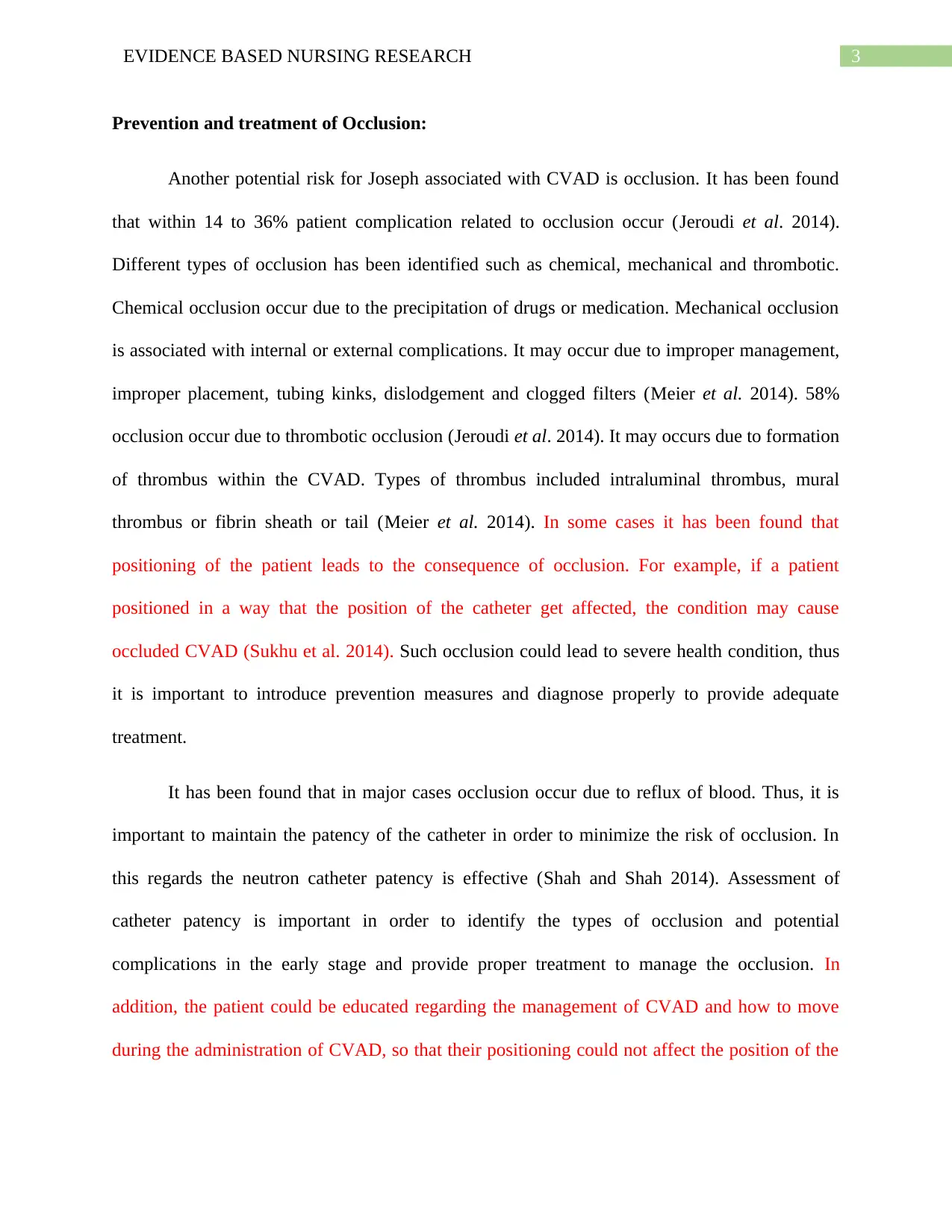
3EVIDENCE BASED NURSING RESEARCH
Prevention and treatment of Occlusion:
Another potential risk for Joseph associated with CVAD is occlusion. It has been found
that within 14 to 36% patient complication related to occlusion occur (Jeroudi et al. 2014).
Different types of occlusion has been identified such as chemical, mechanical and thrombotic.
Chemical occlusion occur due to the precipitation of drugs or medication. Mechanical occlusion
is associated with internal or external complications. It may occur due to improper management,
improper placement, tubing kinks, dislodgement and clogged filters (Meier et al. 2014). 58%
occlusion occur due to thrombotic occlusion (Jeroudi et al. 2014). It may occurs due to formation
of thrombus within the CVAD. Types of thrombus included intraluminal thrombus, mural
thrombus or fibrin sheath or tail (Meier et al. 2014). In some cases it has been found that
positioning of the patient leads to the consequence of occlusion. For example, if a patient
positioned in a way that the position of the catheter get affected, the condition may cause
occluded CVAD (Sukhu et al. 2014). Such occlusion could lead to severe health condition, thus
it is important to introduce prevention measures and diagnose properly to provide adequate
treatment.
It has been found that in major cases occlusion occur due to reflux of blood. Thus, it is
important to maintain the patency of the catheter in order to minimize the risk of occlusion. In
this regards the neutron catheter patency is effective (Shah and Shah 2014). Assessment of
catheter patency is important in order to identify the types of occlusion and potential
complications in the early stage and provide proper treatment to manage the occlusion. In
addition, the patient could be educated regarding the management of CVAD and how to move
during the administration of CVAD, so that their positioning could not affect the position of the
Prevention and treatment of Occlusion:
Another potential risk for Joseph associated with CVAD is occlusion. It has been found
that within 14 to 36% patient complication related to occlusion occur (Jeroudi et al. 2014).
Different types of occlusion has been identified such as chemical, mechanical and thrombotic.
Chemical occlusion occur due to the precipitation of drugs or medication. Mechanical occlusion
is associated with internal or external complications. It may occur due to improper management,
improper placement, tubing kinks, dislodgement and clogged filters (Meier et al. 2014). 58%
occlusion occur due to thrombotic occlusion (Jeroudi et al. 2014). It may occurs due to formation
of thrombus within the CVAD. Types of thrombus included intraluminal thrombus, mural
thrombus or fibrin sheath or tail (Meier et al. 2014). In some cases it has been found that
positioning of the patient leads to the consequence of occlusion. For example, if a patient
positioned in a way that the position of the catheter get affected, the condition may cause
occluded CVAD (Sukhu et al. 2014). Such occlusion could lead to severe health condition, thus
it is important to introduce prevention measures and diagnose properly to provide adequate
treatment.
It has been found that in major cases occlusion occur due to reflux of blood. Thus, it is
important to maintain the patency of the catheter in order to minimize the risk of occlusion. In
this regards the neutron catheter patency is effective (Shah and Shah 2014). Assessment of
catheter patency is important in order to identify the types of occlusion and potential
complications in the early stage and provide proper treatment to manage the occlusion. In
addition, the patient could be educated regarding the management of CVAD and how to move
during the administration of CVAD, so that their positioning could not affect the position of the
Paraphrase This Document
Need a fresh take? Get an instant paraphrase of this document with our AI Paraphraser
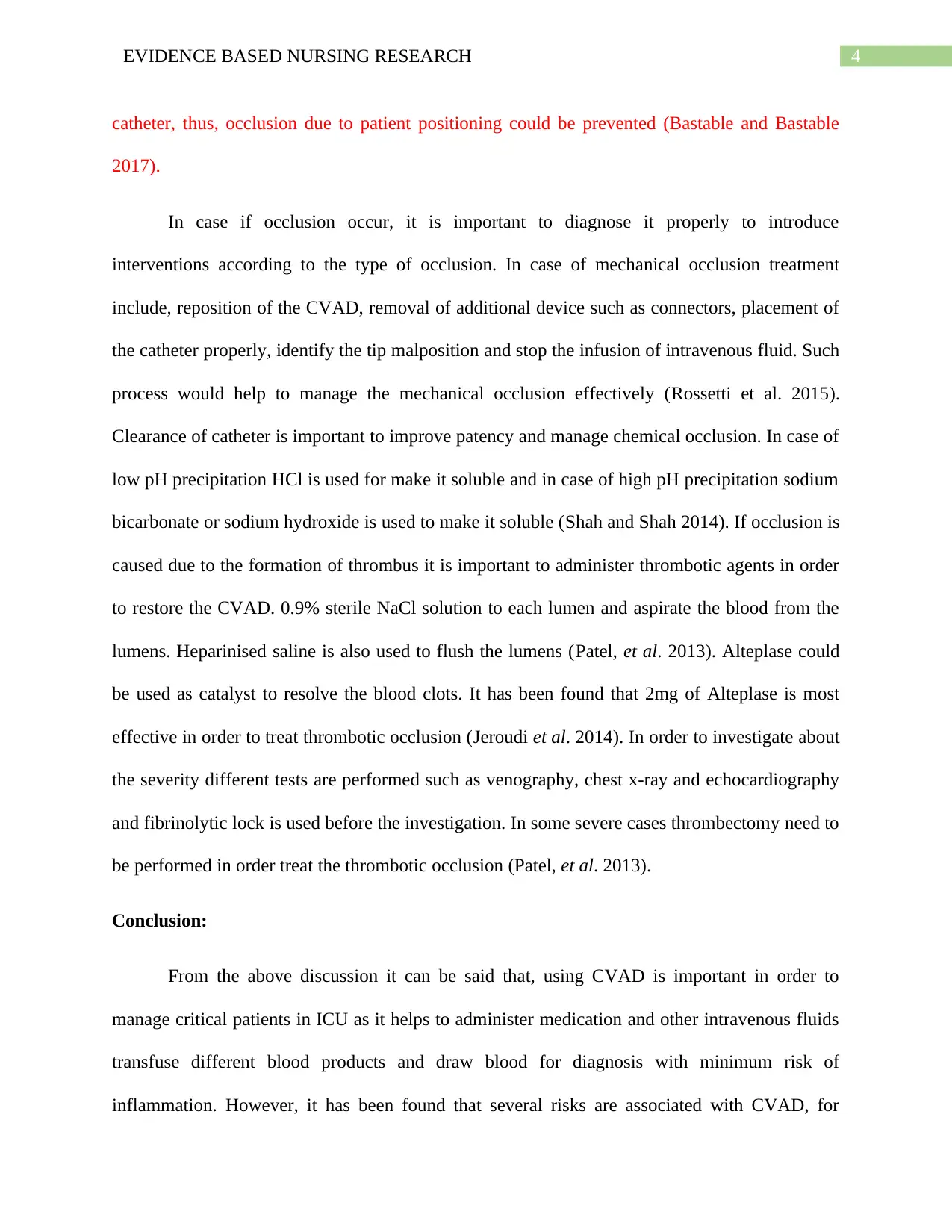
4EVIDENCE BASED NURSING RESEARCH
catheter, thus, occlusion due to patient positioning could be prevented (Bastable and Bastable
2017).
In case if occlusion occur, it is important to diagnose it properly to introduce
interventions according to the type of occlusion. In case of mechanical occlusion treatment
include, reposition of the CVAD, removal of additional device such as connectors, placement of
the catheter properly, identify the tip malposition and stop the infusion of intravenous fluid. Such
process would help to manage the mechanical occlusion effectively (Rossetti et al. 2015).
Clearance of catheter is important to improve patency and manage chemical occlusion. In case of
low pH precipitation HCl is used for make it soluble and in case of high pH precipitation sodium
bicarbonate or sodium hydroxide is used to make it soluble (Shah and Shah 2014). If occlusion is
caused due to the formation of thrombus it is important to administer thrombotic agents in order
to restore the CVAD. 0.9% sterile NaCl solution to each lumen and aspirate the blood from the
lumens. Heparinised saline is also used to flush the lumens (Patel, et al. 2013). Alteplase could
be used as catalyst to resolve the blood clots. It has been found that 2mg of Alteplase is most
effective in order to treat thrombotic occlusion (Jeroudi et al. 2014). In order to investigate about
the severity different tests are performed such as venography, chest x-ray and echocardiography
and fibrinolytic lock is used before the investigation. In some severe cases thrombectomy need to
be performed in order treat the thrombotic occlusion (Patel, et al. 2013).
Conclusion:
From the above discussion it can be said that, using CVAD is important in order to
manage critical patients in ICU as it helps to administer medication and other intravenous fluids
transfuse different blood products and draw blood for diagnosis with minimum risk of
inflammation. However, it has been found that several risks are associated with CVAD, for
catheter, thus, occlusion due to patient positioning could be prevented (Bastable and Bastable
2017).
In case if occlusion occur, it is important to diagnose it properly to introduce
interventions according to the type of occlusion. In case of mechanical occlusion treatment
include, reposition of the CVAD, removal of additional device such as connectors, placement of
the catheter properly, identify the tip malposition and stop the infusion of intravenous fluid. Such
process would help to manage the mechanical occlusion effectively (Rossetti et al. 2015).
Clearance of catheter is important to improve patency and manage chemical occlusion. In case of
low pH precipitation HCl is used for make it soluble and in case of high pH precipitation sodium
bicarbonate or sodium hydroxide is used to make it soluble (Shah and Shah 2014). If occlusion is
caused due to the formation of thrombus it is important to administer thrombotic agents in order
to restore the CVAD. 0.9% sterile NaCl solution to each lumen and aspirate the blood from the
lumens. Heparinised saline is also used to flush the lumens (Patel, et al. 2013). Alteplase could
be used as catalyst to resolve the blood clots. It has been found that 2mg of Alteplase is most
effective in order to treat thrombotic occlusion (Jeroudi et al. 2014). In order to investigate about
the severity different tests are performed such as venography, chest x-ray and echocardiography
and fibrinolytic lock is used before the investigation. In some severe cases thrombectomy need to
be performed in order treat the thrombotic occlusion (Patel, et al. 2013).
Conclusion:
From the above discussion it can be said that, using CVAD is important in order to
manage critical patients in ICU as it helps to administer medication and other intravenous fluids
transfuse different blood products and draw blood for diagnosis with minimum risk of
inflammation. However, it has been found that several risks are associated with CVAD, for
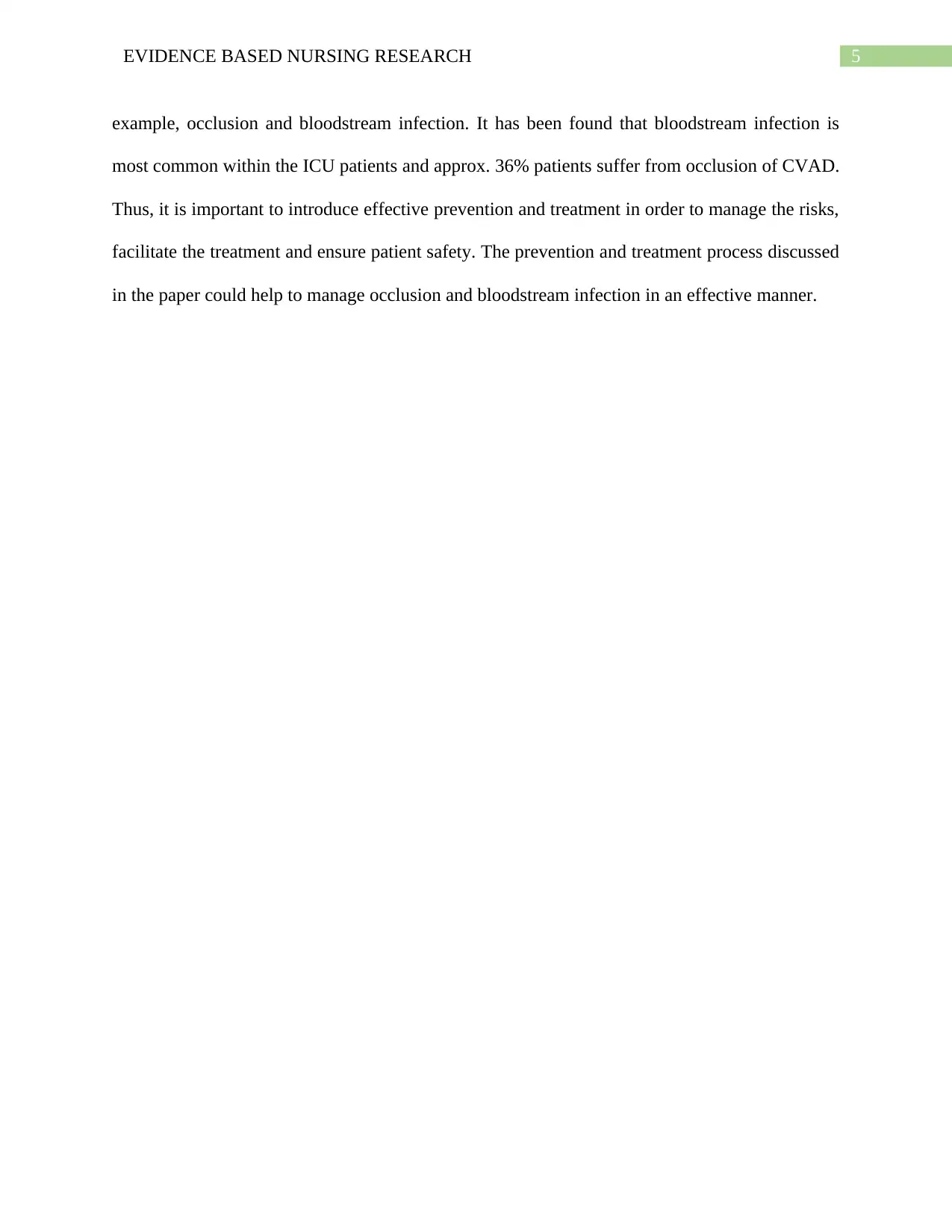
5EVIDENCE BASED NURSING RESEARCH
example, occlusion and bloodstream infection. It has been found that bloodstream infection is
most common within the ICU patients and approx. 36% patients suffer from occlusion of CVAD.
Thus, it is important to introduce effective prevention and treatment in order to manage the risks,
facilitate the treatment and ensure patient safety. The prevention and treatment process discussed
in the paper could help to manage occlusion and bloodstream infection in an effective manner.
example, occlusion and bloodstream infection. It has been found that bloodstream infection is
most common within the ICU patients and approx. 36% patients suffer from occlusion of CVAD.
Thus, it is important to introduce effective prevention and treatment in order to manage the risks,
facilitate the treatment and ensure patient safety. The prevention and treatment process discussed
in the paper could help to manage occlusion and bloodstream infection in an effective manner.
⊘ This is a preview!⊘
Do you want full access?
Subscribe today to unlock all pages.

Trusted by 1+ million students worldwide
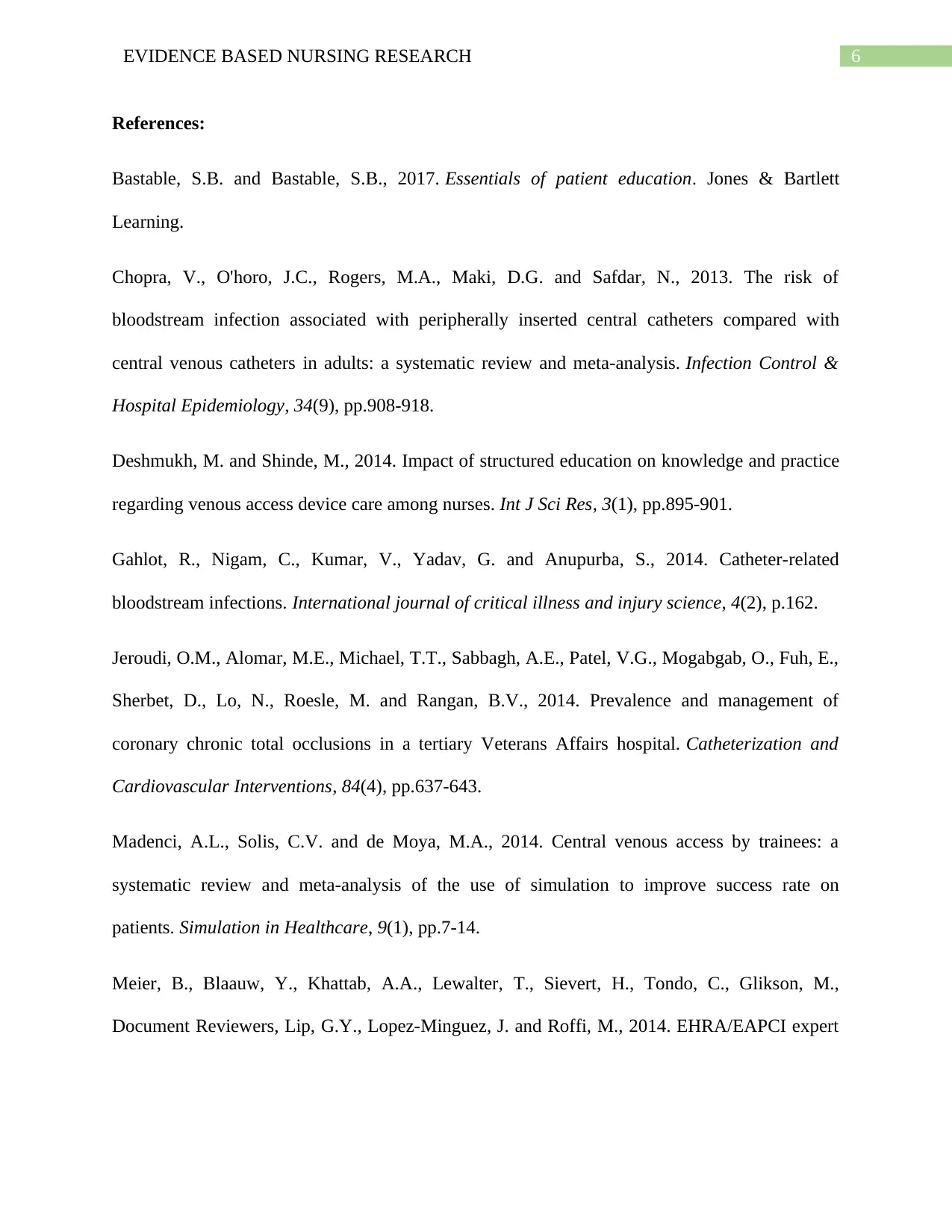
6EVIDENCE BASED NURSING RESEARCH
References:
Bastable, S.B. and Bastable, S.B., 2017. Essentials of patient education. Jones & Bartlett
Learning.
Chopra, V., O'horo, J.C., Rogers, M.A., Maki, D.G. and Safdar, N., 2013. The risk of
bloodstream infection associated with peripherally inserted central catheters compared with
central venous catheters in adults: a systematic review and meta-analysis. Infection Control &
Hospital Epidemiology, 34(9), pp.908-918.
Deshmukh, M. and Shinde, M., 2014. Impact of structured education on knowledge and practice
regarding venous access device care among nurses. Int J Sci Res, 3(1), pp.895-901.
Gahlot, R., Nigam, C., Kumar, V., Yadav, G. and Anupurba, S., 2014. Catheter-related
bloodstream infections. International journal of critical illness and injury science, 4(2), p.162.
Jeroudi, O.M., Alomar, M.E., Michael, T.T., Sabbagh, A.E., Patel, V.G., Mogabgab, O., Fuh, E.,
Sherbet, D., Lo, N., Roesle, M. and Rangan, B.V., 2014. Prevalence and management of
coronary chronic total occlusions in a tertiary Veterans Affairs hospital. Catheterization and
Cardiovascular Interventions, 84(4), pp.637-643.
Madenci, A.L., Solis, C.V. and de Moya, M.A., 2014. Central venous access by trainees: a
systematic review and meta-analysis of the use of simulation to improve success rate on
patients. Simulation in Healthcare, 9(1), pp.7-14.
Meier, B., Blaauw, Y., Khattab, A.A., Lewalter, T., Sievert, H., Tondo, C., Glikson, M.,
Document Reviewers, Lip, G.Y., Lopez-Minguez, J. and Roffi, M., 2014. EHRA/EAPCI expert
References:
Bastable, S.B. and Bastable, S.B., 2017. Essentials of patient education. Jones & Bartlett
Learning.
Chopra, V., O'horo, J.C., Rogers, M.A., Maki, D.G. and Safdar, N., 2013. The risk of
bloodstream infection associated with peripherally inserted central catheters compared with
central venous catheters in adults: a systematic review and meta-analysis. Infection Control &
Hospital Epidemiology, 34(9), pp.908-918.
Deshmukh, M. and Shinde, M., 2014. Impact of structured education on knowledge and practice
regarding venous access device care among nurses. Int J Sci Res, 3(1), pp.895-901.
Gahlot, R., Nigam, C., Kumar, V., Yadav, G. and Anupurba, S., 2014. Catheter-related
bloodstream infections. International journal of critical illness and injury science, 4(2), p.162.
Jeroudi, O.M., Alomar, M.E., Michael, T.T., Sabbagh, A.E., Patel, V.G., Mogabgab, O., Fuh, E.,
Sherbet, D., Lo, N., Roesle, M. and Rangan, B.V., 2014. Prevalence and management of
coronary chronic total occlusions in a tertiary Veterans Affairs hospital. Catheterization and
Cardiovascular Interventions, 84(4), pp.637-643.
Madenci, A.L., Solis, C.V. and de Moya, M.A., 2014. Central venous access by trainees: a
systematic review and meta-analysis of the use of simulation to improve success rate on
patients. Simulation in Healthcare, 9(1), pp.7-14.
Meier, B., Blaauw, Y., Khattab, A.A., Lewalter, T., Sievert, H., Tondo, C., Glikson, M.,
Document Reviewers, Lip, G.Y., Lopez-Minguez, J. and Roffi, M., 2014. EHRA/EAPCI expert
Paraphrase This Document
Need a fresh take? Get an instant paraphrase of this document with our AI Paraphraser
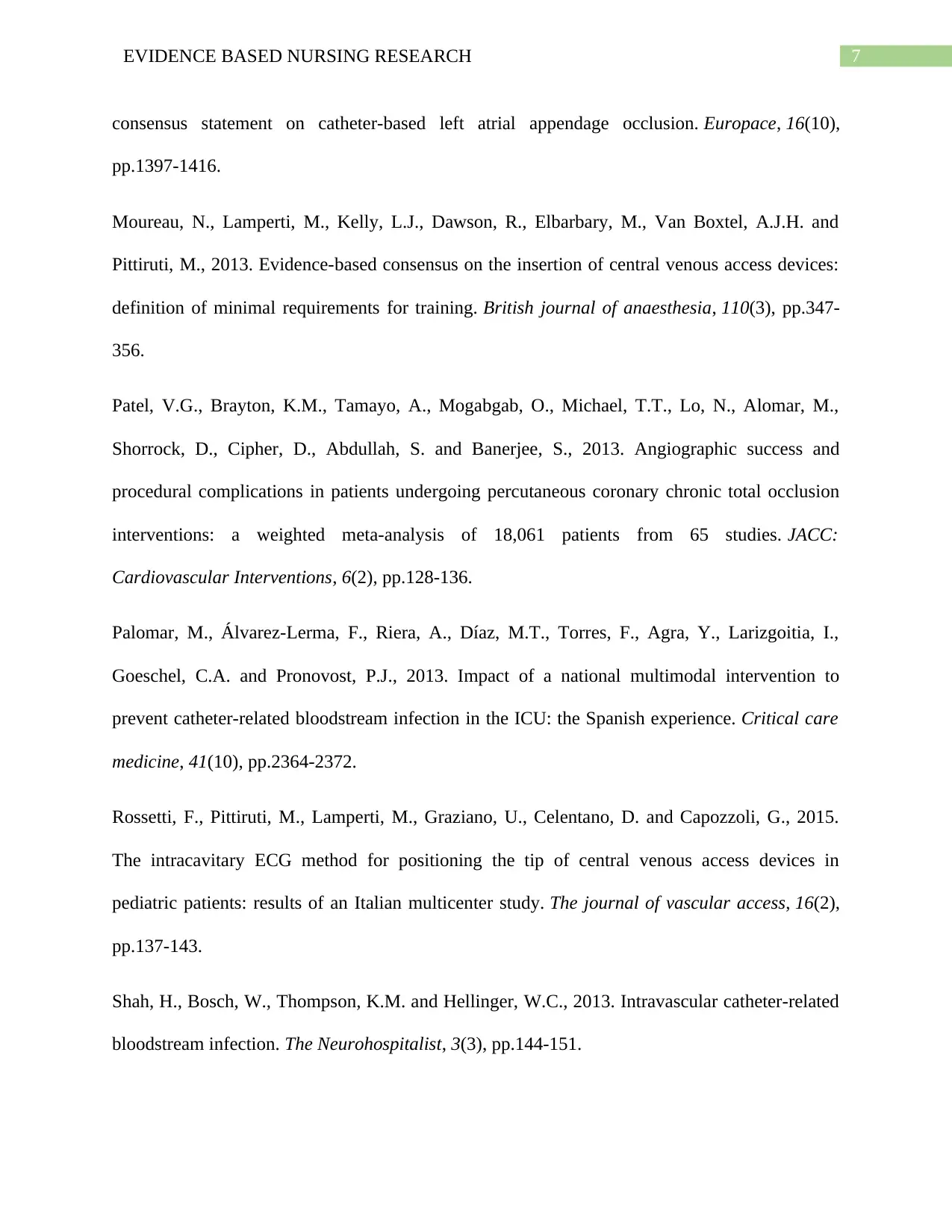
7EVIDENCE BASED NURSING RESEARCH
consensus statement on catheter-based left atrial appendage occlusion. Europace, 16(10),
pp.1397-1416.
Moureau, N., Lamperti, M., Kelly, L.J., Dawson, R., Elbarbary, M., Van Boxtel, A.J.H. and
Pittiruti, M., 2013. Evidence-based consensus on the insertion of central venous access devices:
definition of minimal requirements for training. British journal of anaesthesia, 110(3), pp.347-
356.
Patel, V.G., Brayton, K.M., Tamayo, A., Mogabgab, O., Michael, T.T., Lo, N., Alomar, M.,
Shorrock, D., Cipher, D., Abdullah, S. and Banerjee, S., 2013. Angiographic success and
procedural complications in patients undergoing percutaneous coronary chronic total occlusion
interventions: a weighted meta-analysis of 18,061 patients from 65 studies. JACC:
Cardiovascular Interventions, 6(2), pp.128-136.
Palomar, M., Álvarez-Lerma, F., Riera, A., Díaz, M.T., Torres, F., Agra, Y., Larizgoitia, I.,
Goeschel, C.A. and Pronovost, P.J., 2013. Impact of a national multimodal intervention to
prevent catheter-related bloodstream infection in the ICU: the Spanish experience. Critical care
medicine, 41(10), pp.2364-2372.
Rossetti, F., Pittiruti, M., Lamperti, M., Graziano, U., Celentano, D. and Capozzoli, G., 2015.
The intracavitary ECG method for positioning the tip of central venous access devices in
pediatric patients: results of an Italian multicenter study. The journal of vascular access, 16(2),
pp.137-143.
Shah, H., Bosch, W., Thompson, K.M. and Hellinger, W.C., 2013. Intravascular catheter-related
bloodstream infection. The Neurohospitalist, 3(3), pp.144-151.
consensus statement on catheter-based left atrial appendage occlusion. Europace, 16(10),
pp.1397-1416.
Moureau, N., Lamperti, M., Kelly, L.J., Dawson, R., Elbarbary, M., Van Boxtel, A.J.H. and
Pittiruti, M., 2013. Evidence-based consensus on the insertion of central venous access devices:
definition of minimal requirements for training. British journal of anaesthesia, 110(3), pp.347-
356.
Patel, V.G., Brayton, K.M., Tamayo, A., Mogabgab, O., Michael, T.T., Lo, N., Alomar, M.,
Shorrock, D., Cipher, D., Abdullah, S. and Banerjee, S., 2013. Angiographic success and
procedural complications in patients undergoing percutaneous coronary chronic total occlusion
interventions: a weighted meta-analysis of 18,061 patients from 65 studies. JACC:
Cardiovascular Interventions, 6(2), pp.128-136.
Palomar, M., Álvarez-Lerma, F., Riera, A., Díaz, M.T., Torres, F., Agra, Y., Larizgoitia, I.,
Goeschel, C.A. and Pronovost, P.J., 2013. Impact of a national multimodal intervention to
prevent catheter-related bloodstream infection in the ICU: the Spanish experience. Critical care
medicine, 41(10), pp.2364-2372.
Rossetti, F., Pittiruti, M., Lamperti, M., Graziano, U., Celentano, D. and Capozzoli, G., 2015.
The intracavitary ECG method for positioning the tip of central venous access devices in
pediatric patients: results of an Italian multicenter study. The journal of vascular access, 16(2),
pp.137-143.
Shah, H., Bosch, W., Thompson, K.M. and Hellinger, W.C., 2013. Intravascular catheter-related
bloodstream infection. The Neurohospitalist, 3(3), pp.144-151.
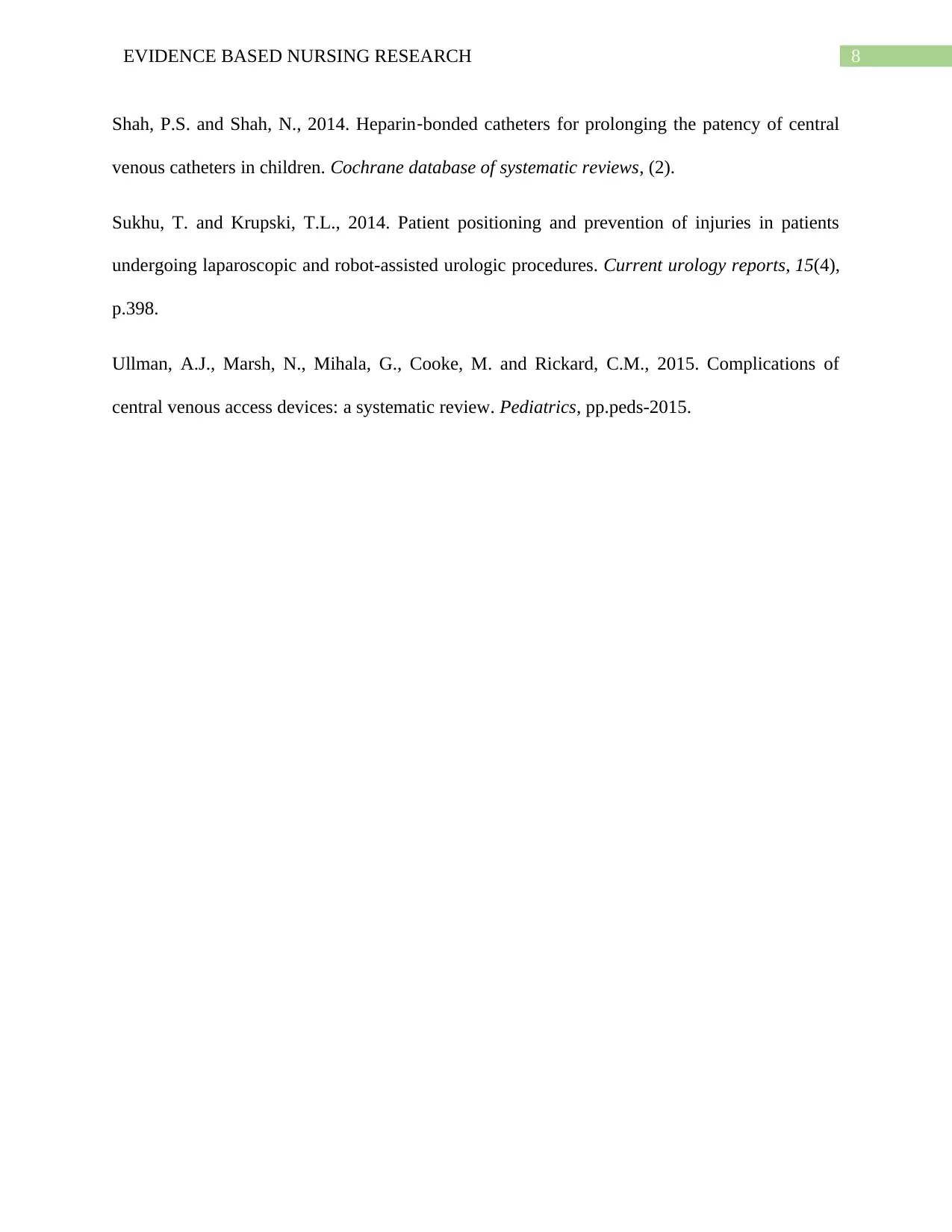
8EVIDENCE BASED NURSING RESEARCH
Shah, P.S. and Shah, N., 2014. Heparin‐bonded catheters for prolonging the patency of central
venous catheters in children. Cochrane database of systematic reviews, (2).
Sukhu, T. and Krupski, T.L., 2014. Patient positioning and prevention of injuries in patients
undergoing laparoscopic and robot-assisted urologic procedures. Current urology reports, 15(4),
p.398.
Ullman, A.J., Marsh, N., Mihala, G., Cooke, M. and Rickard, C.M., 2015. Complications of
central venous access devices: a systematic review. Pediatrics, pp.peds-2015.
Shah, P.S. and Shah, N., 2014. Heparin‐bonded catheters for prolonging the patency of central
venous catheters in children. Cochrane database of systematic reviews, (2).
Sukhu, T. and Krupski, T.L., 2014. Patient positioning and prevention of injuries in patients
undergoing laparoscopic and robot-assisted urologic procedures. Current urology reports, 15(4),
p.398.
Ullman, A.J., Marsh, N., Mihala, G., Cooke, M. and Rickard, C.M., 2015. Complications of
central venous access devices: a systematic review. Pediatrics, pp.peds-2015.
⊘ This is a preview!⊘
Do you want full access?
Subscribe today to unlock all pages.

Trusted by 1+ million students worldwide
1 out of 9
Related Documents
Your All-in-One AI-Powered Toolkit for Academic Success.
+13062052269
info@desklib.com
Available 24*7 on WhatsApp / Email
![[object Object]](/_next/static/media/star-bottom.7253800d.svg)
Unlock your academic potential
Copyright © 2020–2025 A2Z Services. All Rights Reserved. Developed and managed by ZUCOL.





